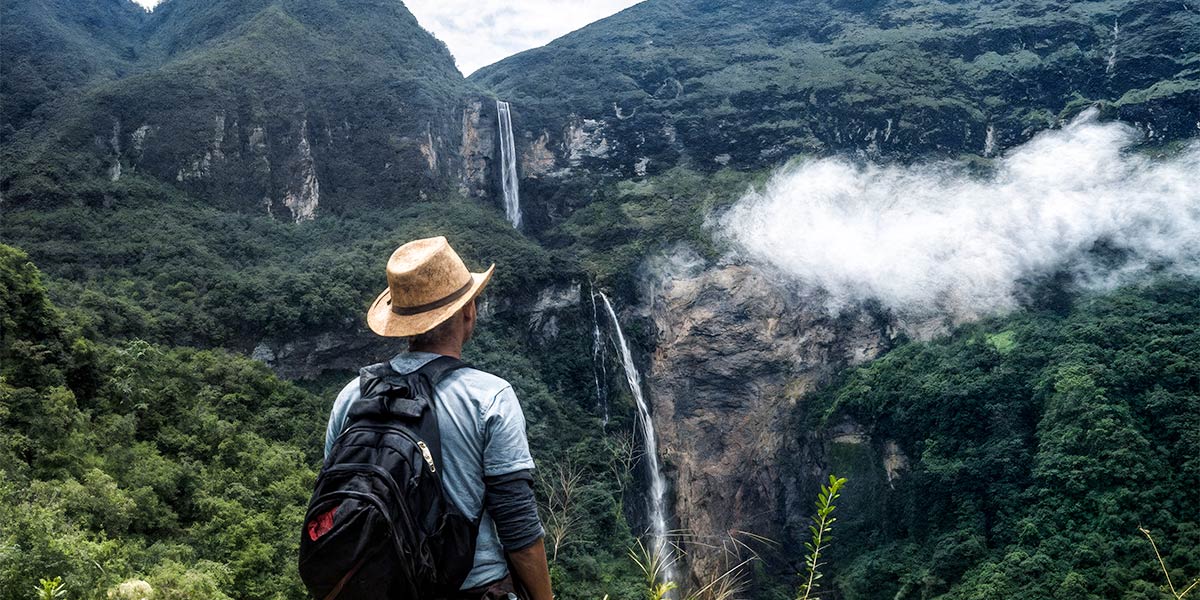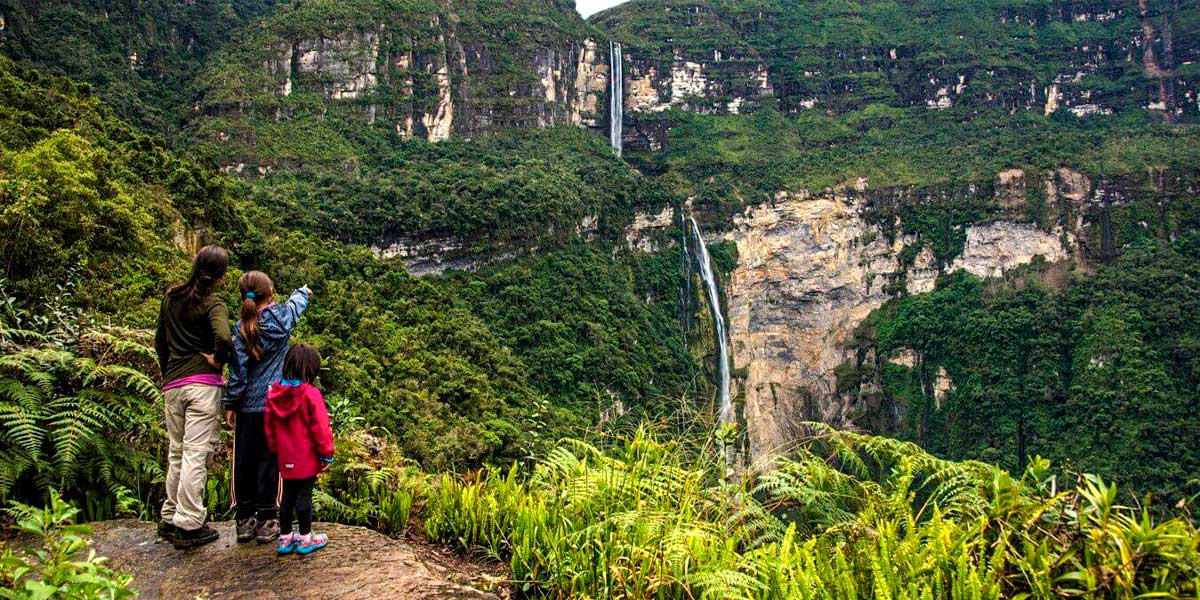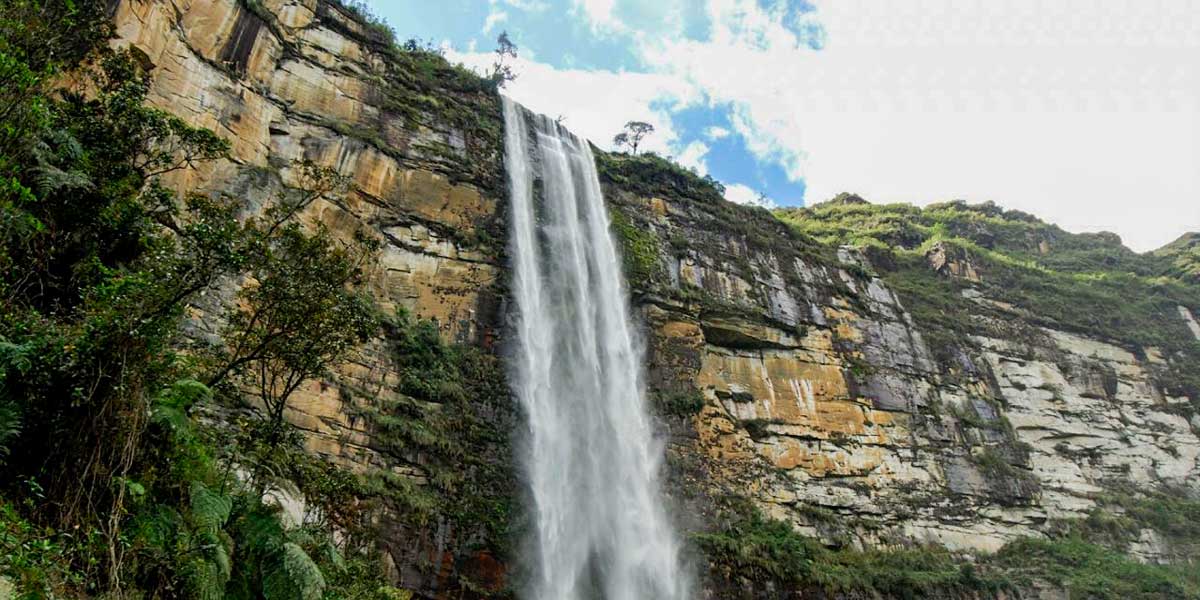In the Amazonas region, various archaeological treasures and remarkable landscapes unfold, such as the Sarcophagi of Karajía, the City of Chachapoyas, or the impressive Kuélap Monumental Archaeological Zone. However, one of the biggest attractions in the area is Gocta, located in the heart of the Peruvian Amazon. With a height of more than 700 meters, the Gocta Waterfall is among the highest on the planet; its beauty is the result of centuries of geological and climatic processes.
The Gocta Waterfall Peru attracts travelers who seek to enjoy wide landscapes and see one of the most beautiful settings in Peru. However, the route to this waterfall has no paved roads or direct motorized transport, which implies traveling through the jungle environment on a quiet walk.
Where is the Gocta Waterfall located?
Geographically, the Gocta Waterfall is located between the hamlets of San Pablo, Cocachimba, and La Coca, in the Valera district, Bongará province, Amazonas region. To visit it, there are different routes that depart from Chachapoyas, both by bus and private transport to Cocachimba or San Pablo, from where horseback riding or walking tours begin.
Gocta Waterfall: The history and the legend
The Gocta Waterfall was discovered in 2002. The German explorer Stefan Ziemendorf was investigating a series of caves found in the department of Amazonas, but it was not until four years later that he made, together with a group of the most experienced local guides, the first records and research on the waterfall, since it had confirmed that this attraction had not been previously discovered.
His topographic notes showed that the Gocta Waterfall measured 771 meters -being the third largest waterfall in Peru, only behind Las Tres Hermanas (914) and Yumbilla (895.4), located in the regions of Junín and Amazonas, respectively- and that In the surroundings of this beautiful natural wonder that is divided into two falls, there are some 22 smaller waterfalls.
As a result of its discovery, the first legends that relate the waterfall to mythology were also born. One of the ones that gained more weight over the years was the story of a golden-haired mermaid who scared away visitors from Amazonas. This woman spent the night in the lagoon that lies at the end of the Gocta Waterfall Peru, with the mission of protecting a brilliant treasure. And those who had the little fortune to get close, made them disappear.
Who discovered the Gocta Waterfall
This Gocta waterfall was discovered in 2002 thanks to the German expeditionist Stefan Ziemendorff and a group of Peruvian explorers who were working on a hydraulic project.
Ziemendorff saw this marvelous waterfall for the first time that year when he was on expeditions in the area. But it was only in 2006 that the news of the existence of this waterfall was given to the world.
It should be noted that Gocta Peru is below El Salto del Ángel, in Venezuela, at 972 meters, Tugela Falls, in South Africa, at 948 meters, among others.
The find caught the attention of the government, which subsequently campaigned to turn it into a tourist attraction that currently boosts the local economy.
It is planned that the area will become a nature reserve because the place is still virgin and there are animals in danger of extinction.
curiosities of the Gocta Waterfall
- The Gocta Waterfall amazes any tourist who comes to appreciate its enormous waterfall, which measures 771 meters. This spectacle of nature is located between the hamlets of San Pablo, Cocachimba and La Coca, which belong to the district of Valera, in the province of Bongará, Amazonas.
- The waterfall was considered the third highest waterfall in the world, although it currently occupies position 17. In Peru it is located in third place, since in the first position is the Las Tres Hermanas waterfall (914 m) located in Junín and in second place is the Yumbilla waterfall (895.4 m) located in Amazonas.
- This impressive waterfall was discovered by the German Stefan Ziemendorff in 2002. The explorer was the one who noticed its existence when he was looking for some sarcophagi located on the opposite side of the Utcubamba valley, in the province of Luya-Lamud, in Amazon. "We reached the base, it falls from very high, so the water is very cold, a lot of cold air falls. The wind that comes out of the waterfall is spectacular, strong and a sensational noise is heard several kilometers away," Ziemendorff told the BBC in the 2006.
- The name Gocta means "jabot" in Quechua. However, for some locals, the name of the waterfall comes from the sound produced by the yellow-tailed woolly monkey that lives in the area and for others it is the onomatopoeia of the noise of the drops when they collide with the stone.
- There are various legends that locals did not want to go near the falls. One of the many is that a blonde-haired mermaid guarded the place and was in the lower area of the waterfall. Even the people who live in Cocachimba say that a person would have disappeared in the waters of the waterfall.
- In order to see the first waterfall up close, you have to take a long walk that lasts approximately 6 hours (round trip). The second fall lasts 8 hours (round trip). On the way you will find extensive vegetation and various animals that inhabit the place.
- The town of Cocachimba is the starting point to go to the Gocta Waterfall Peru. There are several restaurants there and they rent special canes to do the tour. If you do not want to do the long walk you can choose to go on a horse or donkey, which has a price equivalent to S/ 50.
What is the best season to visit this attraction?
The Gocta waterfall can be visited throughout the year, although in the rainy season that runs from December to March, you will be able to appreciate them in their maximum splendor.
It should be noted that the area is home to a great diversity of important animals such as Johnson's spoonbill, spectacled bear and the yellow-tailed woolly monkey. Also, species of wildlife that are in danger of extinction and are on the red list of the International Union for Conservation of Nature.
On April 26, 2019, the Ministry of the Environment recognized the gocta falls peru as a Private Conservation Area (ACP) to protect the water resources, flora and fauna of the place.
How to Get to Gocta Waterfall?
To marvel at this unique place, the first step is to get to Chachapoyas, the capital of the Amazonas region. If you travel from Lima by land, the journey takes around 24 hours and the ticket costs about 80 soles. Another option is to take a flight from Lima to Jaén, Tarapoto, or Cajamarca, and from there continue the journey by bus to Chachapoyas.
To access the waterfalls, your immediate destination will be the town of Cocachimba. You can get there by shared taxi or tourist bus in approximately one hour. From this point, a walk of between five and six hours (round trip) begins, after paying the entrance ticket and guide service. It is advisable to prepare physically before the trip, as the first sections of the trail have steep slopes that require effort.
As you advance, the journey becomes more pleasant. The murmur of the water and the singing of birds like the cock of the rock accompany each step, making the walk more enjoyable; after crossing a thick stretch of trees, the waterfall is found.
Chachapoyas – Cocachimba Route
The Gocta waterfall is located 44 kilometers north of Chachapoyas. The car journey takes about an hour. Upon arriving in Cocachimba, a walk of approximately six hours (round trip) begins along a path that crosses a forest frequently covered by mist.
Chachapoyas – San Pablo Route
The journey from Chachapoyas to San Pablo also takes about an hour. From this town, a trail with ascents and descents begins, but with wide and panoramic views of Gocta Peru. It is the longest path, although San Pablo offers better tourist facilities compared to Cocachimba, which is ideal if you are looking for greater comfort before or after the walk.
Tourist Circuit in the region
The Gocta waterfall is visited by many tourists, who leave from the city of Chachapoyas, being able to appreciate flora and fauna of the coast and mountains on their journey. There is accommodation in Cochachimba that allows rest in view of the waterfall.
This visit is part of the northern tourist circuit of Peru, which during its stage within the Amazon region also includes visits to natural reserves in the jungle, in still virgin areas and which are homes to many species of animals in danger of extinction. In addition, the circuit includes other places such as the pre-Hispanic fortress of Kuelap, ruins of a fortress built by the Chachapoyas Culture between the 10th and 14th centuries, the Sarcophagi of Carajía, the Revash mausoleums, the Lagoon of the Condors, among others.
The Gocta Falls Peru can be visited throughout the year, however, greater caution should be taken during the rainy season that runs from October to May. It is recommended to have items for the walk (cap, binoculars, sunglasses, sunscreen and water), and in the rainy season consider boots, jacket or waterproof poncho. It is important to note that it is possible to rent horses in Cocachimba and San Pablo de Valera to travel part of the route.
Best Tours in Peru
Many are the routes that take you to Machu Picchu, but none is like the Inca Trail tours, the most famous pedestrian path in the Americas. After flying from the capital of Peru, Lima, you will arrive in Cusco to walk for four days along a path through forests and dense fog, millenary stone steps and discovering the ruins of ancient fortifications and Inca cities, and all the time enjoying majestic views.
- Sacred Valley Bike Tour
- Honeymoon in Machu Picchu
- 1 Day Inca Trail Hike to Machu Picchu
- Sacred Valley Tours
- Lares Trek to Machu Picchu 4 Days
- Huchuy Qosqo Trek to Machu Picchu
- Short 2 Day Inca Trail Hike to Machu Picchu
- 2 Day Inca Trail with Camping
- Apu Ausangate Trek 7 days
- 4 Day Jungle Trek to Machu Picchu
- Inca Quarry Trail to Machu Picchu
- Urubamba River Rafting
- 5 Days Salkantay Mountain Trek
- 3 Days Salkantay Trek to Machu Picchu
- Huchuy Qosqo Trek to Machu Picchu
- 7 Lakes Ausangate Trek
If you want to visit Machu Picchu, we recommend you to book your Machu Picchu ticket in advance, so you will enjoy your vacation in Machu Picchu without any problem.









